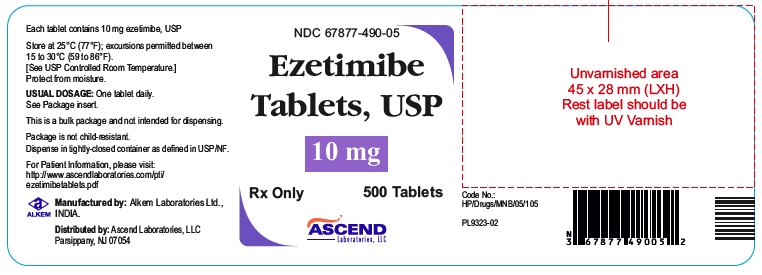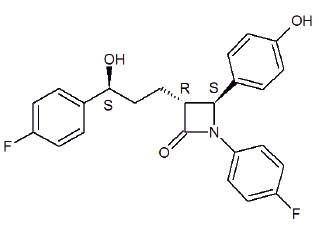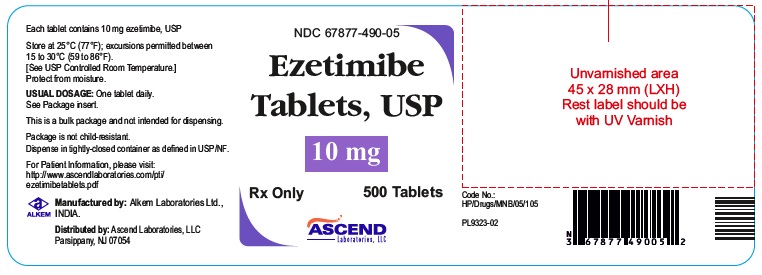Primary Hyperlipidemia in Adults
-
Ezetimibe Tablet reduces total-C, LDL-C, Apo B, and non-HDL-C in patients with hyperlipidemia. Maximal to near maximal response is generally achieved within 2 ...
Primary Hyperlipidemia in Adults
Ezetimibe Tablet reduces total-C, LDL-C, Apo B, and non-HDL-C in patients with hyperlipidemia. Maximal to near maximal response is generally achieved within 2 weeks and maintained during chronic therapy.
Monotherapy
In two multicenter, double-blind, placebo-controlled, 12-week trials in 1719 patients (age range 18 to 86 years, 52% females; 91% White, 5% Black or African American, 1% Asian, 3% other races mostly identified as Hispanic or Latino ethnicity) with primary hyperlipidemia, ezetimibe tablet significantly lowered total-C, LDL-C, Apo B, and non-HDL-C compared to placebo (see Table 6). Reduction in LDL-C was consistent across age, sex, and baseline LDL-C.
TABLE 6: Response to Ezetimibe Tablet in Patients with Primary Hyperlipidemia (Mean % Change from Untreated Baseline*)
*Baseline -on no lipid-lowering drug.
†Ezetimibe Tablet significantly reduced total-C, LDL-C, Apo B, and non-HDL-C compared to placebo.
Combination with Statins: Ezetimibe Tablet Added to On-going Statin Therapy
In a multicenter, double-blind, placebo-controlled, 8-week trial, 769 patients (age range 22 to 85 years, 42% females; 90% White, 6% Black or African American, 1% Asian, 3% other races; and 2% identified as Hispanic or Latino ethnicity) with primary hyperlipidemia, known coronary heart disease or multiple cardiovascular risk factors who were already receiving statin monotherapy but who had not met their NCEP ATP II target LDL-C goal, were randomized to receive either ezetimibe tablet or placebo in addition to their on-going statin.
Ezetimibe Tablet, added to on-going statin therapy, significantly lowered total-C, LDL-C, Apo B, and non-HDL-C compared with a statin administered alone (see Table 7). LDL-C reductions induced by Ezetimibe Tablet were generally consistent across all statins.
TABLE 7: Response to Addition of Ezetimibe Tablet to On-Going Statin Therapy* in Patients with Hyperlipidemia (Mean % Change from Treated Baseline† )
* Patients receiving each statin: 40% atorvastatin, 31% simvastatin, 29% others (pravastatin, fluvastatin, cerivastatin, lovastatin).
† Baseline - on a statin alone.
‡ Ezetimibe Tablet + statin significantly reduced total-C, LDL-C, Apo B, and non-HDL-C compared to statin alone.
Combination with Statins: Ezetimibe Tablet Initiated Concurrently with a Statin
In four multicenter, double-blind, placebo-controlled, 12-week trials, in 2,382 patients (age range 18 to 87 years, 57% female; 88% White, 5% Black or African American, 2% Asian, 5% other races mostly identified as Hispanic or Latino) with hyperlipidemia, ezetimibe tablet or placebo was administered alone or with various doses of atorvastatin, simvastatin, pravastatin, or lovastatin.
When all patients receiving ezetimibe tablet with a statin were compared to all those receiving the corresponding statin alone, ezetimibe tablet significantly lowered total-C, LDL-C, Apo B, and non-HDL-C compared to the statin administered alone. LDL-C reductions induced by ezetimibe tablet were generally consistent across all statins. (See footnote †, Tables 8 to 11.)
TABLE 8: Response to Ezetimibe Tablet and Atorvastatin Initiated Concurrently in Patients with Primary Hyperlipidemia (Mean % Change from Untreated Baseline*)
*Baseline - on no lipid-lowering drug.
†Ezetimibe Tablets + all doses of atorvastatin pooled (10-80 mg) significantly reduced total-C, LDL-C, Apo B, and non-HDL-C compared to all doses of atorvastatin pooled (10-80 mg).
TABLE 9: Response to Ezetimibe Tablet and Simvastatin Initiated Concurrently in Patients with Primary Hyperlipidemia (Mean % Change from Untreated Baseline*)
* Baseline - on no lipid-lowering drug.
† Ezetimibe Tablets + all doses of simvastatin pooled (10-80 mg) significantly reduced total-C, LDL-C, Apo B, and non-HDL-C compared to all doses of simvastatin pooled (10-80 mg).
TABLE 10: Response to Ezetimibe Tablet and Pravastatin Initiated Concurrently in Patients with Primary Hyperlipidemia (Mean % Change from Untreated Baseline*)
*Baseline - on no lipid-lowering drug.
† Ezetimibe Tablet + all doses of pravastatin pooled (10-40 mg) significantly reduced total-C, LDL-C, Apo B, and non- HDL-C compared to all doses of pravastatin pooled (10-40 mg).
TABLE 11: Response to Ezetimibe Tablet and Lovastatin Initiated Concurrently in Patients with Primary Hyperlipidemia (Mean % Change from Untreated Baseline*)
*Baseline - on no lipid-lowering drug.
†Ezetimibe Tablet + all doses of lovastatin pooled (10-40 mg) significantly reduced total-C, LDL-C, Apo B, and non-HDL-C compared to all doses of lovastatin pooled (10-40 mg).
Combination with Fenofibrate
In a multicenter, double-blind, placebo-controlled, clinical trial in patients with mixed hyperlipidemia, 625 patients (age range 20 to 76 years, 44% female; 79% White, 1% Black or African American, 20% other races; and 11% identified as Hispanic or Latino ethnicity) were treated for up to 12 weeks and 576 for up to an additional 48 weeks. Patients were randomized to receive placebo, ezetimibe tablet alone, 160 mg fenofibrate alone, or ezetimibe tablet and 160 mg fenofibrate in the 12-week trial. After completing the 12-week trial, eligible patients were assigned to ezetimibe tablet coadministered with fenofibrate or fenofibrate monotherapy for an additional 48 weeks.
Ezetimibe Tablet coadministered with fenofibrate significantly lowered total-C, LDL-C, Apo B, and non-HDL-C compared to fenofibrate administered alone (see Table 12).
TABLE 12: Response to Ezetimibe Tablet and Fenofibrate Initiated Concurrently in Patients with Mixed Hyperlipidemia (Mean % Change from Untreated Baseline* at 12 weeks)
*Baseline - on no lipid-lowering drug.
The changes in lipid endpoints after an additional 48 weeks of treatment with ezetimibe tablet coadministered with fenofibrate or with fenofibrate alone were consistent with the 12-week data displayed above.
HeFH in Pediatric Patients
The effects of ezetimibe tablet coadministered with simvastatin (n=126) compared to simvastatin monotherapy (n=122) have been evaluated in males and females with HeFH. In a multicenter, double-blind, controlled trial followed by an open-label phase, 142 males and 106 postmenarchal females, 10 to 17 years of age (mean age 14.2 years, 43% females, 82% White, 4% Asian, 2% Black or African American, 13% multi- racial; 14% identified as Hispanic or Latino ethnicity) with HeFH were randomized to receive either ezetimibe tablet coadministered with simvastatin or simvastatin monotherapy. Inclusion in the trial required 1) a baseline LDL-C level between 160 and 400 mg/dL and 2) a medical history and clinical presentation consistent with HeFH. The mean baseline LDL-C value was 225 mg/dL (range: 161 to 351 mg/dL) in the ezetimibe tablet coadministered with simvastatin group compared to 219 mg/dL (range: 149 to 336 mg/dL) in the simvastatin monotherapy group. The patients received coadministered ezetimibe tablet and simvastatin (10 mg, 20 mg, or 40 mg) or simvastatin monotherapy (10 mg, 20 mg, or 40 mg) for 6 weeks, coadministered ezetimibe tablet and 40- mg simvastatin or 40-mg simvastatin monotherapy for the next 27 weeks, and open-label coadministered ezetimibe tablet and simvastatin (10 mg, 20 mg, or 40 mg) for 20 weeks thereafter.
The results of the trial at Week 6 are summarized in Table 13. Results at Week 33 were consistent with those at Week 6.
TABLE 13: Mean Percent Difference at Week 6 Between the Pooled Ezetimibe Tablet Coadministered with Simvastatin Group and the Pooled Simvastatin Monotherapy Group in Adolescent Patients with HeFH
HoFH in Adults and Pediatric Patients
A trial was conducted to assess the efficacy of ezetimibe tablet in the treatment of HoFH. This double-blind, randomized, 12-week trial enrolled 50 patients (age range 11 to 74 years, 58% female; 90% White, 2% Black or African American, 8% other races identified as Hispanic or Latino) with a clinical and/or genotypic diagnosis of HoFH, with or without concomitant LDL apheresis, already receiving atorvastatin or simvastatin (40 mg). Patients were randomized to one of three treatment groups, atorvastatin or simvastatin (80 mg), ezetimibe tablet administered with atorvastatin or simvastatin (40 mg), or ezetimibe tablet administered with atorvastatin or simvastatin (80 mg). Due to decreased bioavailability of ezetimibe in patients concomitantly receiving cholestyramine [see Drug Interactions (7)], ezetimibe was dosed at least 4 hours before or after administration of resins. Mean baseline LDL-C was 341 mg/dL in those patients randomized to atorvastatin 80 mg or simvastatin 80 mg alone and 316 mg/dL in the group randomized to ezetimibe tablet plus atorvastatin 40 or 80 mg or simvastatin 40 or 80 mg. Ezetimibe tablet, administered with atorvastatin or simvastatin (40- and 80-mg statin groups, pooled), significantly reduced LDL-C (21%) compared with increasing the dose of simvastatin or atorvastatin monotherapy from 40 to 80 mg (7%). In those treated with ezetimibe tablet plus 80-mg atorvastatin or with ezetimibe tablet plus 80-mg simvastatin, LDL-C was reduced by 27%.
Homozygous Sitosterolemia (Phytosterolemia) in Adults and Pediatric Patients
A trial was conducted to assess the efficacy of ezetimibe tablet in the treatment of homozygous sitosterolemia. In this multicenter, double-blind, placebo-controlled, 8-week trial, 37 patients (age range 9 to 72 years, 65% females; 89% White, 3% Asian, 8% other races identified as Hispanic or Latino) with homozygous sitosterolemia with elevated plasma sitosterol levels (>5 mg/dL) on their current therapeutic regimen (diet, bile-acid-binding resins, statins, ileal bypass surgery and/or LDL apheresis), were randomized to receive ezetimibe tablet (n=30) or placebo (n=7). Due to decreased bioavailability of ezetimibe in patients concomitantly receiving cholestyramine [see Drug Interactions (7)], ezetimibe tablet was dosed at least 2 hours before or 4 hours after resins were administered. Excluding the one subject receiving LDL apheresis, ezetimibe tablet significantly lowered plasma sitosterol and campesterol, by 21% and 24% from baseline, respectively. In contrast, patients who received placebo had increases in sitosterol and campesterol of 4% and 3% from baseline, respectively. For patients treated with ezetimibe tablet, mean plasma levels of plant sterols were reduced progressively over the course of the trial. Reductions in sitosterol and campesterol were consistent between patients taking ezetimibe tablet concomitantly with bile acid sequestrants (n=8) and patients not on concomitant bile acid sequestrant therapy (n=21).
Close









